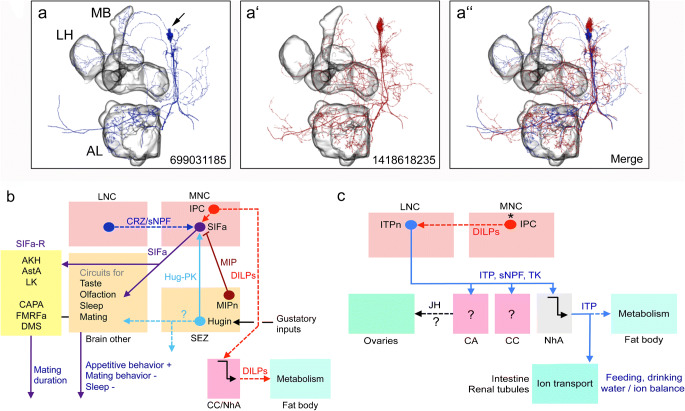Fig. 8.
Schemes depicting circuits/axes involving SIFamide- and ion transport peptide-producing interneurons (ITPn) in adult flies. (a, a’) Reconstructions of two SIFa neurons from serial electron microscopic sections (combined in the third panel, a”). MB, mushroom body, LH, lateral horn, AL, antennal lobe. The numbers identify the neurons in the database. These panels were compiled from data in neuPRINT (https://neuprint.janelia.org) (Clements et al. 2020; Xu et al. 2020; Zheng et al. 2018). (b) SIFamide (SIFa)-producing interneurons are central in regulating appetitive behavior and decreasing sleep and mating behavior. As also shown in Fig. 7, the SIFa neurons are modulated by neurons producing MIP, Hugin-PK and possibly CRZ/sNPF. The SIFa neurons also target SIFa receptor–expressing peptidergic neurons (SIFaR) in the CNS. Of these, AKH-, AstA- and LK-expressing neurons induce shorter mating duration and CAPA-, FMRFa- and DMS-expressing ones induce longer mating (Wong et al. 2019). Dashed lines indicate that actions have not been shown experimentally in the context of SIFa signaling. Peptide acronyms are as in Table 1. (c) Ion transport peptide (ITP) is produced by a set of LNCs (ITPn) that has axon terminations in corpora cardiaca (CC) and allata (CA), as well as neurohemal areas (NhA). ITP regulates water intake and water reabsorption/excretion and possibly metabolism (Galikova et al. 2018). The ITPn are targets of DILP2 from the IPCs (Bader et al. 2013) and express the LK receptor (Zandawala et al. 2018b) but the functional aspects of this are not known

